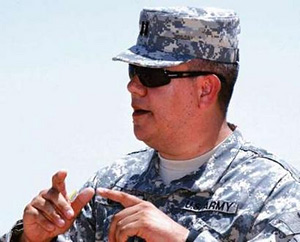 |
 |
 |
 News from Around the Americas | June 2006 News from Around the Americas | June 2006  
Border Role Not New for Discreet US Military Unit
 Tim Gaynor - Reuters Tim Gaynor - Reuters


| | Army National Guard Captain Talon Greeff discusses the road building project the guard unit from Utah will be working on along the Arizona-Mexico border in San Luis, Arizona June 5, 2006. (The Yuma Sun/Terry Ketron) |
While the first U.S. National Guard troops are finding their feet in a new role on the Mexico border this week, one discreet military unit has aided police there and on the Canadian frontier for years.

Last month President George W. Bush ordered 6,000 troops to help Border Patrol agents secure the porous frontier, and the first few soldiers arrived in Arizona earlier this week.

The deployment has upset many in Mexico who say they are unhappy at the increasing militarization of the border, while some residents in U.S. border states remained skeptical about the role troops will play there.

But a cadre of Marines, soldiers, sailors, airmen and defense department civilian specialists have used cutting-edge military technologies and know-how to help federal law enforcement there since the 1980s.

Originally called Joint Task Force Six, the group includes engineers, map makers, radar and intelligence specialists and was founded in 1989 to help federal police curb drug smuggling over the 2,000-mile (3,200-km) Mexico border.

Renamed Joint Task Force North two years ago, it was given a broader role to support law enforcement agencies in efforts to secure the U.S. mainland from threats including "international terrorism" and drug trafficking.

"Working on the border is nothing new for the military, we've been supporting law enforcement there for years," said Col. Barry Cronin, JTFN's deputy commander, adding that they would be there "after the National Guard has gone."

In 2005, the El Paso, Texas-based unit carried out 63 operations nationwide, including 55 on the Canadian and Mexican borders. Its kit includes unmanned aerial drones, combat radar systems, long-range infrared optics, and seismic detectors.

"Typically we'll go in with our planning and organizational abilities, offering federal law enforcement agencies a kind of one-stop shopping for all their needs," said Lt. Col. Dan Drew, JTFN's chief of future operations.

Utah National Guard troops arrived in Yuma, Arizona, this week, where they will patch border fencing and add security lighting, and New Mexico National Guard troops are due to deploy to Las Cruces over the weekend.

They are the first of several units that will help the Border Patrol secure the border for up to a year. They are set to play a support role and will stop short of making arrests.

SUPPORTING THE BORDER PATROL

Joint Task Force North is not involved in the National Guard deployment. But the scope and nature of the unit's prior support to federal law enforcement is evident in a Mexico border operation last year.

Dubbed Operation Western Vigilance, the deployment of 400 military personnel to deserts west of El Paso enabled Border Patrol agents to arrest 2,020 intruders from Mexico and impound more than 1,000 pounds of smuggled drugs.

In it, soldiers used high-powered Forward Looking Infra-Red thermal imaging sensors to provide the Border Patrol with advanced intelligence on traffickers and undocumented immigrants as they trekked north from staging areas in Mexico.

The operation also used Hunter aerial drones from a military intelligence battalion to monitor movements along the Arizona-Mexico border, and sent Marine Corps engineers to put up lighting along a steel border fence in Arizona.

Another operation, on the Canadian border, threw a battlefield radar net across a stretch of coast between British Columbia and Washington State to help agencies like the Border Patrol and the Royal Canadian Mounted Police track smugglers in a cross-border marijuana trade valued at $6 billion a year. | 
 | |
 |



